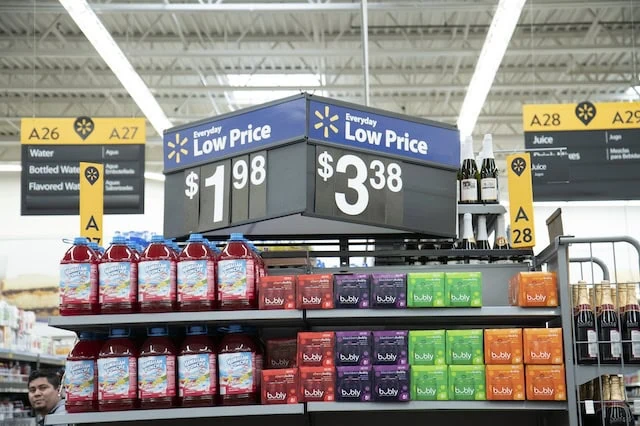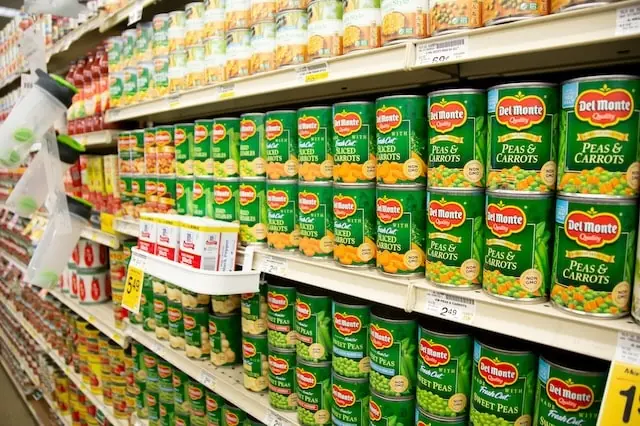Quick quiz: The economy starts to show signs of weakness, and you fear it’s only a matter of time before those cracks bleed into the stock market. What do you do?
If you’re a tried-and-true buy-and-holder, the answer might very well be “nothing.” But if you like to tinker with your portfolio even a little, you might seek out a bit of protection … and if so, you very well could find yourself embracing one of the market’s consumer staples exchange-traded funds (ETFs).
Consumer staples are a classic investment hiding spot because of their role in delivering some of people’s most basic needs. You need to eat, you need to brush your teeth, and as Del the Funky Homosapien would be forced to say in a G-rated movie, you need to wash your derrière. Consumer staples provide the necessary goods to make those things happen.
Let me walk you through three of the best consumer staples ETFs you can buy. While all consumer staples funds have numerous similarities—after all, they hold stocks from the exact same sector—each fund is built a little differently from one another. That in turn provides investors with a few different angles for approaching the consumer staples sector.
Disclaimer: This article does not constitute individualized investment advice. These securities appear for your consideration and not as personalized investment recommendations. Act at your own discretion.
Why Consumer Staples Stocks?

We slice and dice the stock market into all sorts of categories based on a variety of characteristics: value vs. growth, large caps vs. mid-caps vs. small caps, and so on.
Well, one of the most common ways to divvy up the market is into cyclical and defensive sectors.
Cyclical stocks have a tendency to rise and fall based on the economic cycle, whereas defensive stocks are more capable of maintaining their value regardless of what the economy is doing. And consumer staples fall neatly into the latter.
I’ve found the easiest way to think about consumer staples is this: They’re companies that either produce or sell any goods you need to buy regularly and somewhat frequently. Food. Beverages. Personal-care products like toothpaste and shampoo. Household goods such as laundry detergent and toilet paper. No matter what the economy looks like, you’re going to keep on buying those products because you have to.
Compare that with consumer cyclical companies, which produce or sell any goods you need to buy, but irregularly and less frequently (a car, shoes, clothes) or goods you want to buy (video games, food eaten at restaurants). If the economy tanks, you’ll probably slow or pause your purchase of these goods.
The only confusing exceptions that fall within the consumer staples umbrella are alcohol and tobacco. You could argue those aren’t technically “needs.” And I could argue back that you’ve clearly never spent time as a writer or a waiter.
The Best Consumer Staples ETFs

If you’re investing in consumer staples, it’s a fairly safe assumption that you’re doing so for their defensive and/or income properties, and that you want to stick with U.S.-centric funds.
Exceptions exist for people who want something different.There are global consumer staples funds that invest in both American companies as well as staples stocks headquartered outside the U.S. There are even small-cap consumer staples ETFs that exclusively invest in staples stocks that are sometimes more niche or more growthy than your average large-cap staples firm.
But the best consumer staples ETFs that I want to highlight here all boast the sector’s most sought-after characteristics.
Related: 3 Best Utility ETFs You Can Buy
1. Consumer Staples Select Sector SPDR Fund

- Inception: Dec. 16, 1998
- Assets under management: $15.8 billion
- Dividend yield: 2.7%
- Expense ratio: 0.08%, or 80¢ per year on every $1,000 invested
State Street Investment Management’s Select Sector SPDRs, which launched in the late 1990s, are the oldest sector funds on the block. As is frequently the case with first-mover funds, they’re also the biggest sector funds there are.
And thanks to a January 2025 fee cut, they’re all among, tied for, or sit alone as the cheapest funds covering each sector.
That includes the Consumer Staples Select Sector SPDR Fund (XLP), which holds all of the consumer staples stocks in the S&P 500 (currently 37). What kinds of staples stocks? Well, about 30% of XLP’s assets is invested in distribution-and-retail stocks such as Walmart (WMT) and Costco Wholesale (COST); household products, beverages, and food products are each weighted in the high teens; tobacco stocks make up about 10%, and the remaining 3% or so are in personal-care products.
Like the S&P 500 itself, this consumer staples fund is market cap-weighted, which means generally speaking, the larger the company, the greater the percentage of assets XLP will invest in the company. Also, XLP’s index has a couple of “caps” that ensure after each quarterly rebalancing: a.) no single stock makes up more than 25% of the index, and b.) the total weight of companies with individual weights greater than 4.8% doesn’t exceed 50% of the total index weight.* Basically, this prevents the fund from hyper-concentrating its assets in just one or a few stocks.
Still, XLP has some pretty sizable weights (8%-10%) in mega-cap stocks Costco, Walmart, and Procter & Gamble (PG). For the most part, high concentrations in larger companies tends to result in more stable, but less “growthy,” performance compared to funds that spread their assets more equally among smaller companies. Indeed, not only is XLP’s 2.7% yield more than twice what the S&P 500 provides, but it’s also one of the higher yields among consumer staples ETFs.
The Consumer Staples Select Sector SPDR Fund has long been an absolute juggernaut in the space, and it currently boasts nearly $16 billion in assets—more than double the next-biggest staples ETF. But thanks to a January 2025 fee cut to just 0.08% annually, it has also surpassed the next fund on our list as the lowest-cost staples fund. Between that and straightforward access to the sector’s biggest blue chips, XLP clearly deserves recognition as one of the best consumer staples ETFs you can buy.
Want to learn more about XLP? Check out the State Street Investment Management provider site.
2. Fidelity MSCI Consumer Staples Index ETF

- Inception: Oct. 21, 2013
- Assets under management: $1.3 billion
- Dividend yield: 2.3%
- Expense ratio: 0.084%, or 84¢ per year on every $1,000 invested
The Fidelity MSCI Consumer Staples Index ETF (FSTA) stands out for its wider coverage of the consumer staples sector.
This Fidelity ETF tracks the MSCI USA IMI Consumer Staples 25/50 Index, which itself is a subset of a U.S. stock index that’s much broader than the S&P 500. The “25/50” refers to a pair of constraints: No stock can exceed 25% of the index weight, and all stocks with a weight above 5% can’t exceed 50% of the index weight, at each quarterly rebalancing. (So, for instance, if a stock rocketed higher and exceeded the 25% weight cap just before rebalancing, then at rebalancing, its weight would be reduced to under 25%.)
The result is a portfolio of more than 100 companies. The breakdown of consumer staples industries, such as distribution-and-retail and household products, is fairly similar to XLP, with a difference of just a few percentage points (at most) in either direction. FSTA’s index is modified market cap-weighted, too, so bigger stocks command more assets. Top holdings are the same, too, with Walmart, Costco, and P&G all commanding low double-digit weights right now.
The most notable difference is that, by casting a wider net, Fidelity’s ETF provides more exposure to mid- and small-cap consumer staples stocks. Specifically, about 12% of FSTA’s assets are invested in midsized and small companies vs. just 3% for XLP.
That might not seem like much—it definitely doesn’t push the overall size needle far, with the Fidelity MSCI Consumer Staples ETF and the Select Sector fund each averaging about $110 billion in average weighted market cap. However, this difference peeks out in FSTA’s yield (which while still higher than the market average is typically lower than XLP’s) and a superior growth profile—in fact, FSTA has outperformed XLP on a total-return basis (price plus dividends) over every meaningful time period since the fund’s inception.
Fidelity’s fund technically costs more than XLP, but by less than 1 basis point annually. (A basis point is one one-hundredth of a percentage point.) That seems like more than a fair tradeoff for the outperformance, and it justifies FSTA’s seat among the best consumer staples ETFs.
Want to learn more about FSTA? Check out the Fidelity provider site.
3. iShares U.S. Consumer Staples ETF

- Inception: June 21, 2000
- Assets under management: $1.3 billion
- Dividend yield: 2.4%
- Expense ratio: 0.40%, or $4.00 per year on every $1,000 invested
On its face, the iShares U.S. Consumer Staples ETF (IYK) isn’t materially different from the other two consumer staples ETFs on this list.
IYK tracks a modified market cap-weighted index: The Russell 1000 Consumer Staplers RIC 22.5/45 Capped Index. In short: It holds any consumer staples companies within the market’s 1,000 largest stocks. And it has a capping system similar to FSTA, where at each quarterly rebalancing, no stock can exceed a weight of 22.5%, and the combined weight of all stocks weighed at 4.5% or more can’t add up to more than 45%.
The portfolio is 55 stocks wide and predominantly large-cap in nature. IYK’s smaller average weighted market cap ($95 billion) isn’t because it holds many mid- and small-cap stocks (it doesn’t), but because it holds more stocks on the small end of the large-cap spectrum. Again, it’s pretty similar in profile to the other two funds.
Where iShares’ fund goes wildly off track is how it views the distribution-and-retail industry. Namely, while IYK considers grocers like Kroger (KR) and pharmacies like Walgreens (WBA) and CVS Health (CVS) to be within the consumer staples fold, it excludes the likes of Costco, Walmart, and Target (TGT), which account for 20%-25% of assets in XLP and FSTA. Indeed, those three retailers are found in iShares’ consumer discretionary ETF, IYC.
IYK instead distributes that weight into greater shares of food, beverages, tobacco, and household goods.
I could make the arguments for and against including those retailers in consumer staples. What’s much more difficult to argue is the impact it has had on IYK’s returns. iShares launched its ETF in 2000, less than two years after XLP’s launch—and despite a slow first couple of years, it has walloped the Select Sector fund by some 215 percentage points on a total-return basis (price plus dividends), with a significant chunk of that outperformance coming since the COVID bottom. That more than justifies IYK’s higher annual fee.
Want to learn more about IYK? Check out the iShares provider site.







